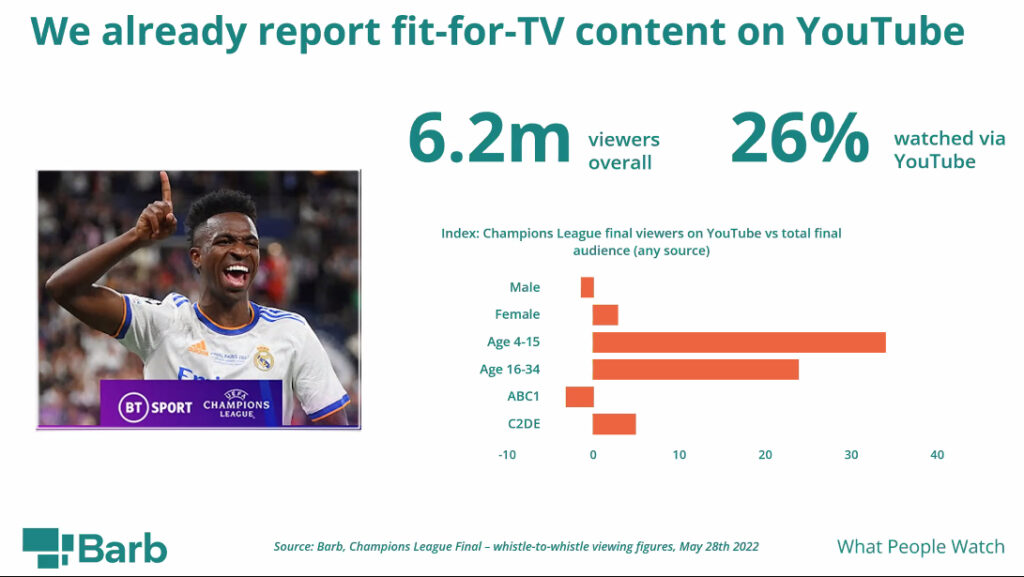UK TV measurement body Barb is exploring the measurement of ads on Netflix’s ad tier, the organisation said in a briefing this morning.
Barb already measures viewing on Netflix, alongside other streaming services, but is now developing a proof of concept that would allow advertisers to identify and measure the spots they have booked for their clients.
“We’re striving for a privacy-safe, double-blind matching of our data sets to provide advertisers and agencies with a view of effective audiences, helping them understand which audiences their ads haven’t reached yet, while reducing ad repetitions for the same individuals,” said Khaled El Serafy, Head of Data Science at Barb.
The initial phase looks to measure ads on the TV set, where 85-86 percent of SVOD viewing takes place, according to Barb’s data. The second phase will consider how best to report the ad viewing data. The organisation hopes to complete the first phase towards the end of 2023.
Disentangling ads from content
The identification of ads on TV requires different technology to content, which is handled by Kantar’s monitoring service using audio referencing techniques. Because ads are shorter they require more granular monitoring, so Barb uses watermarking techniques to identify ads as separate from content.
“Currently, there is very little advertising that is watermarked,” noted Matt Laycock, Audiences Director at Barb. “We want to work with the industry, in order to make sure that watermarking does come through the relevant systems, so that we can identify that using the metering technology that we have.”
Though the proof of concept is looking specifically at tracking ads on Netflix, Laycock added that the watermarking technology can be rolled out to any platform, “for the benefit of the whole industry, not just for the SVODs.”
A separate proof of concept sees Barb collaborating with Snowflake and Infosum to explore options enabling the safe sharing of data between companies, including the use of clean rooms. The organisation will then develop use cases for data integration.
Support for advertisers
Barb also gave updates on its new viewing data API that was launched in January. An industry consultation in 2022 found that advertisers require Barb’s data in formats they can easily ingest into their campaign-planning tools. “Our intention is to provide support to enable users to be able to do that much more easily, to take the data and process it, convert it into reach and frequency campaigns,” said Jim Jarrett, Head of Research Operations at Barb.
The API currently only covers linear channel reporting, and Barb will be extending the API in the second half of this year, in order to include AVOD, SVOD and video sharing platforms.
Measuring “fit-for-TV” content on video sharing platforms is another area of focus, as Barb assesses the level at which content is reported. “Service level viewing will undoubtedly continue to be part of the service that we provide,” noted Laycock. “But with the sheer number of videos being uploaded to video sharing platforms on an hourly basis, careful consideration will need to be given to how best to ensure the industry can look at and take decisions with the data that we provide.”
Measuring co-viewing
The measurement body also shared plans to reduce zero-rated spots, where niche TV channels can appear to have zero viewership. Its recently announced panel expansion is expected to address this issue, growing from 5,150 to 7,000 homes, or 16,000 individuals. The expansion is due to be completed in 2024.
“It will have a great impact on minimising data variability and zero-rated spots, whilst also allowing us to try multiple recruitment methods to ensure the future of a high-quality probabilistic panel into the next few decades,” said Caroline Baxter, Research Operations Director at Barb.
Barb noted that its methodology can capture viewing by guests in a panelist’s home, which can be disentangled from co-viewing among members of the household. “The core feature of the panel data is that we’re capturing the viewing done to the screen by everyone in front of it, something that server-based or IP data will struggle to match,” noted Laycock.
The data shows that widely watched live events have high levels of co-viewing, for instance 56 percent of the audience for the coronation were watching with someone else. And the coronation, Eurovision and FA Cup semi-finals had triple the average amount of guest viewing, demonstrating the idea of event TV as “social glue” (and confirming the existence of Eurovision parties).
Last week BT Sport announced it will stream this weekend’s Champions League final on YouTube. When the broadcaster did the same last year, Barb found that over a quarter of viewers watched the match on YouTube, including over a third of viewers under-15. “Given last year’s figures, we expect there to be a substantial audience tuning into the game in this fashion,” said Laycock.





